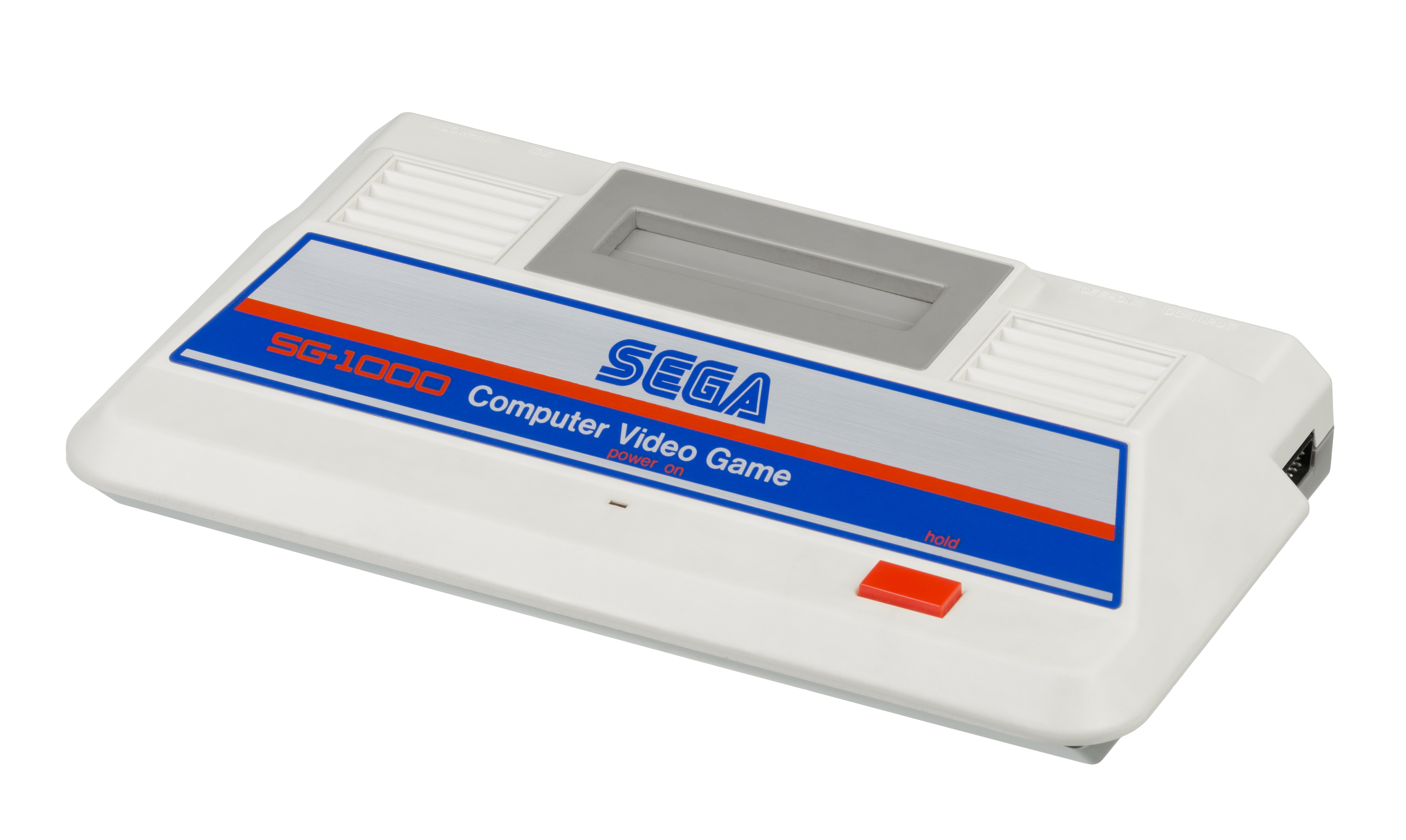|
SF-7000
The is a home video game console manufactured by Sega. It was Sega's first entry into the home video game hardware business. Developed in response to a downturn in arcades starting in 1982, the SG-1000 was created on the advice of Hayao Nakayama, president of Sega's Japanese arm, and was released on July 15, 1983, the same day that Nintendo released the Family Computer in Japan. It also saw limited release in Australia and New Zealand. The SG-1000 was released in several forms, including the SC-3000 computer and the redesigned SG-1000 II released in 1984. The SG-1000 and the SC-3000 both support a library of 76 ROM cartridge games and 29 Sega My Card games. A third iteration of the console, the Sega Mark III, was released in 1985. It provided an improved custom video display processor over previous iterations and served as the basis for the Master System in 1986, Sega's first internationally released console. All SG-1000 games are fully compatible with the Mark III and ... [...More Info...] [...Related Items...] OR: [Wikipedia] [Google] [Baidu] |
Sega
is a Japanese multinational video game and entertainment company headquartered in Shinagawa, Tokyo. Its international branches, Sega of America and Sega Europe, are headquartered in Irvine, California and London, respectively. Its division for the development of both arcade games and home video games, Sega Games, has existed in its current state since 2020; from 2015 to that point, the two had made up separate entities known as Sega Games and Sega Interactive Co., Ltd. Sega is a subsidiary of Sega Sammy Holdings. From 1983 until 2001, Sega also developed video game consoles. Sega was founded by American businessmen Martin Bromley and Richard Stewart as on June 3, 1960; shortly after, the company acquired the assets of its predecessor, Service Games of Japan. Five years later, the company became known as Sega Enterprises, Ltd., after acquiring Rosen Enterprises, an importer of coin-operated games. Sega developed its first coin-operated game, ''Periscope'', in 1966. Sega wa ... [...More Info...] [...Related Items...] OR: [Wikipedia] [Google] [Baidu] |
Japanese Yen
The is the official currency of Japan. It is the third-most traded currency in the foreign exchange market, after the United States dollar (US$) and the euro. It is also widely used as a third reserve currency after the US dollar and the euro. The New Currency Act of 1871 introduced Japan's modern currency system, with the yen defined as of gold, or of silver, and divided decimally into 100 ''sen'' or 1,000 ''rin''. The yen replaced the previous Tokugawa coinage as well as the various ''hansatsu'' paper currencies issued by feudal ''han'' (fiefs). The Bank of Japan was founded in 1882 and given a monopoly on controlling the money supply. Following World War II, the yen lost much of its prewar value. To stabilize the Japanese economy, the exchange rate of the yen was fixed at ¥360 per US$ as part of the Bretton Woods system. When that system was abandoned in 1971, the yen became undervalued and was allowed to float. The yen had appreciated to a peak of ¥271 per US$ i ... [...More Info...] [...Related Items...] OR: [Wikipedia] [Google] [Baidu] |
Future Publishing
Future plc is an international multimedia company established in the United Kingdom in 1985. The company has over 220 brands that span magazines, newsletters, websites, and events in fields such as video games, technology, films, music, photography, home, and knowledge. Zillah Byng-Thorne has been CEO since 2014. The company is listed on the London Stock Exchange and is a constituent of the FTSE 250 Index. History 1985–2012 The company was founded as Future Publishing in Somerton, Somerset, England, in 1985 by Chris Anderson with the sole magazine ''Amstrad Action''. An early innovation was the inclusion of free software on magazine covers; they were the first company to do so. It acquired GP Publications so establishing Future US in 1994. From 1995 to 1997, the company published ''Arcane'', a magazine which largely focused on tabletop games. Anderson sold Future to Pearson plc for £52.7m in 1994, but bought it back in 1998, with Future chief executive Greg Ingham an ... [...More Info...] [...Related Items...] OR: [Wikipedia] [Google] [Baidu] |
Retro Gamer
''Retro Gamer'' is a British magazine, published worldwide, covering retro video games. It was the first commercial magazine to be devoted entirely to the subject. Launched in January 2004 as a quarterly publication, ''Retro Gamer'' soon became a monthly. In 2005, a general decline in gaming and computer magazine readership led to the closure of its publishers, Live Publishing, and the rights to the magazine were later purchased by Imagine Publishing. It was taken over by Future plc on 21 October 2016, following Future's acquisition of Imagine Publishing. History The first 18 issues of the magazine came with a coverdisk. It usually contained freeware remakes of retro video games and emulators, but also videos and free commercial PC software such as '' The Games Factory'' and '' The Elder Scrolls: Arena''. Some issues had themed CDs containing the entire back catalogue of a publisher such as Durell, Llamasoft and Gremlin Graphics. On 27 September 2005, the magazine's origina ... [...More Info...] [...Related Items...] OR: [Wikipedia] [Google] [Baidu] |
Condé Nast
Condé Nast () is a global mass media company founded in 1909 by Condé Montrose Nast, and owned by Advance Publications. Its headquarters are located at One World Trade Center in the Financial District of Lower Manhattan. The company's media brands attract more than 72 million consumers in print, 394 million in digital and 454 million across social platforms. These include '' Vogue'', '' The New Yorker'', '' Condé Nast Traveler'', '' GQ'', ''Glamour'', '' Architectural Digest'', '' Vanity Fair, Pitchfork'', '' Wired'', and '' Bon Appétit,'' among many others. US ''Vogue'' editor-in-chief Anna Wintour serves as Artistic Director and Global Chief Content Officer. In 2011, the company launched the Condé Nast Entertainment division, tasked with developing film, television, social and digital video, and virtual reality content. History The company traces its roots to 1909, when Condé Montrose Nast, a New York City-born publisher, purchased '' Vogue,'' a printed magazin ... [...More Info...] [...Related Items...] OR: [Wikipedia] [Google] [Baidu] |
Wired (magazine)
''Wired'' (stylized as ''WIRED'') is a monthly American magazine, published in print and online magazine, online editions, that focuses on how emerging technologies affect culture, the economy, and politics. Owned by Condé Nast, it is headquartered in San Francisco, California, and has been in publication since March/April 1993. Several spin-offs have been launched, including ''Wired UK'', ''Wired Italia'', ''Wired Japan'', and ''Wired Germany''. From its beginning, the strongest influence on the magazine's editorial outlook came from founding editor and publisher Louis Rossetto. With founding creative director John Plunkett, Rossetto in 1991 assembled a 12-page prototype, nearly all of whose ideas were realized in the magazine's first several issues. In its earliest colophon (publishing), colophons, ''Wired'' credited Canadian media theorist Marshall McLuhan as its "patron saint". ''Wired'' went on to chronicle the evolution of digital technology and its impact on society. ' ... [...More Info...] [...Related Items...] OR: [Wikipedia] [Google] [Baidu] |
Research And Development
Research and development (R&D or R+D), known in Europe as research and technological development (RTD), is the set of innovative activities undertaken by corporations or governments in developing new services or products, and improving existing ones. Research and development constitutes the first stage of development of a potential new service or the production process. R&D activities differ from institution to institution, with two primary models of an R&D department either staffed by engineers and tasked with directly developing new products, or staffed with industrial scientists and tasked with applied research in scientific or technological fields, which may facilitate future product development. R&D differs from the vast majority of corporate activities in that it is not intended to yield immediate profit, and generally carries greater risk and an uncertain return on investment. However R&D is crucial for acquiring larger shares of the market through the marketisation ... [...More Info...] [...Related Items...] OR: [Wikipedia] [Google] [Baidu] |
NewsBank
NewsBank is a news database resource that provides archives of media publications as reference materials to libraries. History John Naisbitt, the author of the book ''Megatrends'', founded NewsBank.Andrews 1998, p. 17. The company was launched in 1972. NewsBank was bought from Naisbitt by Daniel S. Jones, who subsequently became its president. Naisbitt left NewsBank in 1973.McClellan 1987, p. 87. In 1983, NewsBank acquired Readex. With the completion of the merger, NewsBank had acquired one of the earliest organizations in America to archive microform. In 1986, NewsBank had one hundred employees in-house. Another one hundred employees worked from home and traveled to the company's headquarters, bringing back newspapers to their residence from there, and then coming back to the company with indexed information on these publications. The company's headquarters in 1986 was in New Canaan, Connecticut.Andrews 1998, p. 18. Chris Andrews was brought on in 1986 as product manager for ... [...More Info...] [...Related Items...] OR: [Wikipedia] [Google] [Baidu] |
Bally Manufacturing
Bally Manufacturing, later renamed Bally Entertainment, was an American company that began as a pinball and slot machine manufacturer, and later expanded into casinos, video games, health clubs, and theme parks. It was acquired by Hilton Hotels in 1996. Its brand name, and mid-20th century pinball & slot machine logo, are still used by several businesses with some trademark rights, most notably Bally Technologies and Bally's Corporation. History The Bally Manufacturing Corporation was founded by Raymond Moloney on January 10, 1932, when Bally's original parent, Lion Manufacturing, established the company to make pinball games. The company took its name from its first game, "Ballyhoo". The company, based in Chicago, quickly became a leading pinball maker. In the late 1930s, Moloney began making gambling equipment, and had great success developing and improving the mechanical slot machines that were the core of the nascent gaming industry. After manufacturing munitions and a ... [...More Info...] [...Related Items...] OR: [Wikipedia] [Google] [Baidu] |
Arcade Video Game
An arcade video game takes player input from its controls, processes it through electrical or computerized components, and displays output to an electronic monitor or similar display. Most arcade video games are coin-operated, housed in an arcade cabinet, and located in amusement arcades alongside other kinds of arcade games. Until the late 1990s, arcade video games were the largest and most technologically advanced segment of the video game industry. Early prototypical entries '' Galaxy Game'' and '' Computer Space'' in 1971 established the principle operations for arcade games, and Atari's '' Pong'' in 1972 is recognized as the first successful commercial arcade video game. Improvements in computer technology and gameplay design led to a golden age of arcade video games, the exact dates of which are debated but range from the late 1970s to mid-1980s. This golden age includes '' Space Invaders'', '' Pac-Man'', and '' Donkey Kong''. The arcade industry had a resurgence fr ... [...More Info...] [...Related Items...] OR: [Wikipedia] [Google] [Baidu] |
Arcade Game
An arcade game or coin-op game is a coin-operated entertainment machine typically installed in public businesses such as restaurants, bars and amusement arcades. Most arcade games are presented as primarily games of skill and include arcade video games, Pinball machines, electro-mechanical games, redemption games or merchandisers. Types Broadly, arcade games are nearly always considered games of skill, with only some elements of games of chance. Games that are solely games of chance, like slot machines and pachinko, often are categorized legally as gambling devices and, due to restrictions, may not be made available to minors or without appropriate oversight in many jurisdictions. Arcade video games Arcade video games were first introduced in the early 1970s, with '' Pong'' as the first commercially successful game. Arcade video games use electronic or computerized circuitry to take input from the player and translate that to an electronic display such as a monito ... [...More Info...] [...Related Items...] OR: [Wikipedia] [Google] [Baidu] |






